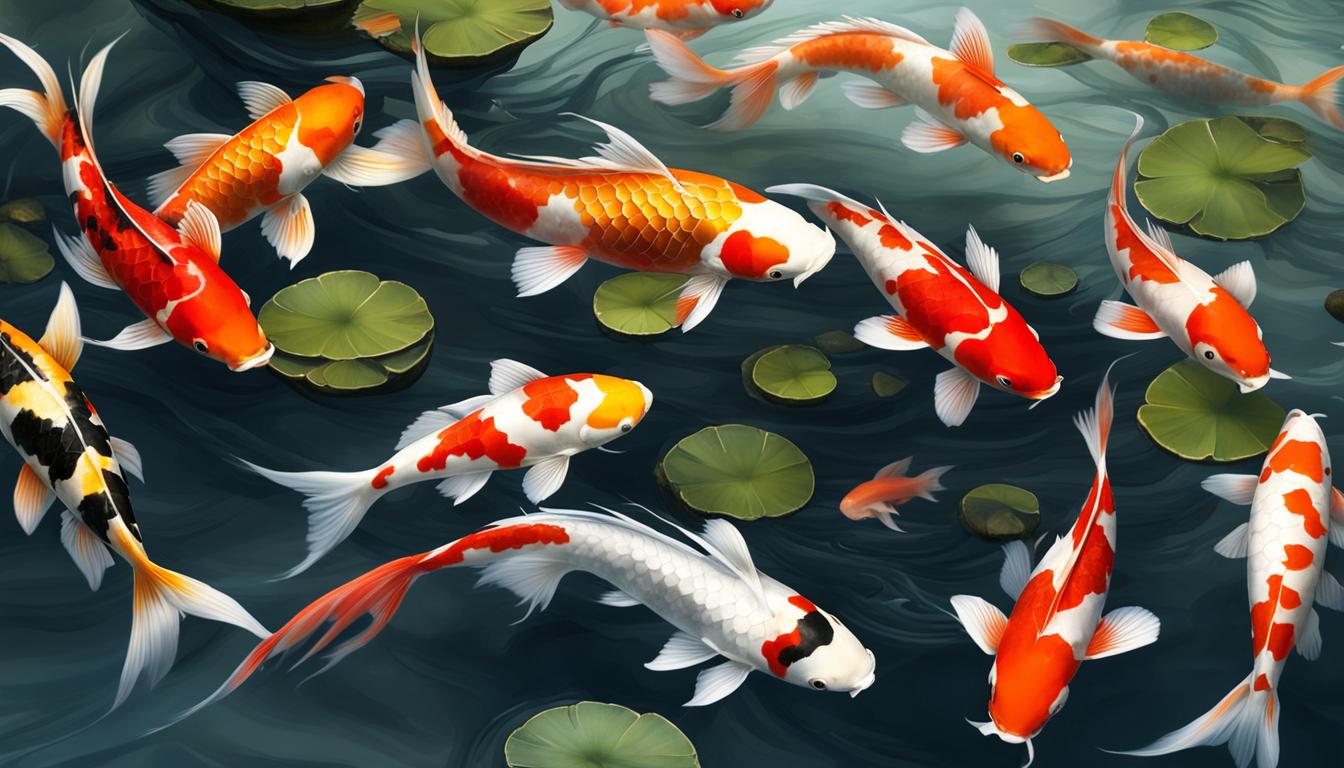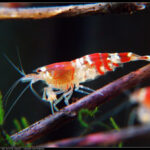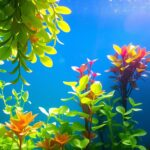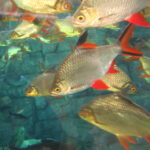The Tomini surgeonfish, also known as Ctenochaetus tominiensis, is a marine fish in the Acanthuridae family. It is widespread in the tropical waters of the central Indo-Pacific region and can grow up to 6 inches in size.
Its diet consists mainly of marine algae and seaweed, although it will also consume meaty flake and frozen foods. Tomini Tangs require a tank size of at least 70 gallons. They are not known to be aggressive but may exhibit sporadic cases of aggression.
Overall, they are suitable for a reef tank and can be a colorful addition to your aquarium.
Table of Contents
Overview Of Tomini Tangs
The Tomini Tang, also known as the Tomini surgeonfish, is a marine fish found in the tropical waters of the central Indo-Pacific region. This beautiful species requires a diet heavy in marine algae and seaweed to maintain its health and immune system.
With its stunning colors and peaceful nature, the Tomini Tang is a popular choice for aquarium enthusiasts.
The Tomini Tang, scientifically known as Ctenochaetus tominiensis, is a popular and fascinating species of marine fish belonging to the family Acanthuridae. This tang is widely distributed throughout the tropical waters of the central Indo-Pacific region, from Indonesia to the Tonga Islands.
Known for its vibrant colors and unique appearance, the Tomini Tang can add a stunning touch to any saltwater aquarium. In this section, we will delve into the habitat and distribution, as well as the appearance and characteristics of this captivating fish.
Habitat And Distribution Of The Tomini Tang
- The Tomini Tang is predominantly found in the central Indo-Pacific region, specifically from Indonesia to the Tonga Islands.
- These fish inhabit coral reefs, lagoons, and rocky areas with abundant coral growth.
- They prefer areas with moderate water flow and plenty of hiding spots, such as caves and crevices.
- Tomini Tangs are usually found at depths ranging from 3 to 30 meters, but can occasionally be spotted at even greater depths.
Appearance And Characteristics Of The Species
- Size: The Tomini Tang typically reaches a maximum length of around 6 inches.
- Body Shape: It possesses a sleek and elongated body shape, with a laterally compressed structure that aids in their swift movements.
- Coloration: The primary body color of the Tomini Tang is a bright yellow, with a darker shade at the back and tail region. It also exhibits prominent blue lines on its face and bright blue accents on the edges of its fins.
- Spine: A unique characteristic of this species is its retractable spine, known as the “scalpel,” located near the base of its tail. This spine is used for defense and is capable of causing injury to predators or intruders.
- Herbivorous Diet: Tomini Tangs are primarily herbivores, feeding on marine algae and seaweed. However, they can also consume meaty flake and frozen foods occasionally, but the majority of their diet should consist of algae and herbivore preparations.
- Peaceful Nature: Unlike some other tang species, Tomini Tangs are generally peaceful and can coexist with a variety of tank mates, as long as they are not aggressive or territorial.
The Tomini Tang is an exquisite addition to any saltwater aquarium, thanks to its stunning colors, sleek body shape, and peaceful nature. Take note of their preferred habitat, diet, and characteristics to ensure optimal care and create a thriving environment for these captivating fish in your own tank.
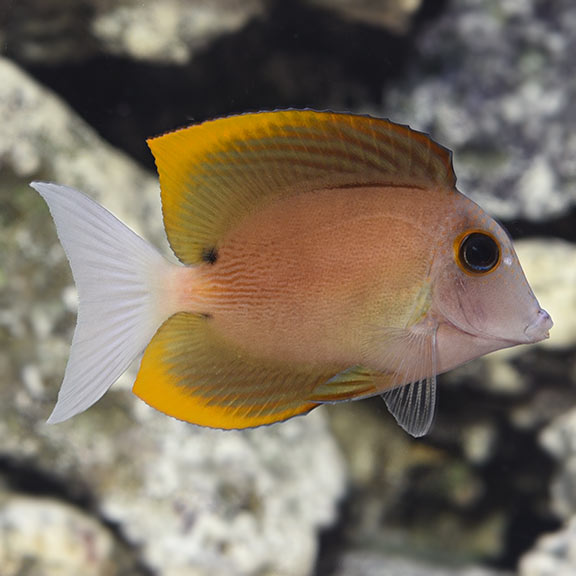
Credit: www.liveaquaria.com
Tank Setup And Maintenance
The Tomini Tang, also known as the Tomini surgeonfish, is a marine fish found in the central Indo-Pacific region. It requires a diet heavy on marine algae and seaweed, but will also consume meaty flake and frozen foods. With a maximum size of 6 inches, it is recommended to keep this fish in a 70-gallon tank.
Whether you’re a seasoned aquarium enthusiast or a beginner, setting up and maintaining the perfect tank for your Tomini Tang is crucial for the health and wellbeing of this beautiful fish. In this section, we’ll discuss the tank size requirements, water quality parameters, filtration and circulation systems, and suitable tank mates for Tomini Tangs.
Tank Size Requirements For Tomini Tangs:
- A minimum tank size of 55 gallons is recommended for a single Tomini Tang.
- Larger tanks are ideal, as they provide more swimming space and a stable environment.
- A spacious tank helps reduce territorial aggression and stress.
Water Quality Parameters For A Healthy Environment:
Maintaining proper water quality is essential for the health of your Tomini Tang. Here are the recommended parameters:
- Temperature: 75°F to 82°F (24°C to 28°C).
- PH level: 8.1 to 8.4.
- Ammonia and nitrite levels should be zero, while nitrate levels should be kept below 20 ppm.
- Regular water testing and water changes are crucial to maintain these parameters.
Proper Filtration And Circulation Systems:
Having an efficient filtration and circulation system is vital to ensure the water in your Tomini Tang’s tank is clean and oxygenated. Consider the following points:
- A high-quality protein skimmer will help remove organic waste, excess nutrients, and ensure good water quality.
- A robust mechanical and biological filtration system is crucial for removing particulate matter and maintaining biological stability.
- Adequate water circulation is essential to mimic the natural ocean currents, helping prevent dead spots and maintaining a healthy environment.
Suitable Tank Mates For Tomini Tangs:
When choosing tank mates for your Tomini Tang, keep in mind their compatibility and territorial nature. Here are some suitable options:
- Peaceful reef-safe fish, such as clownfish, gobies, and wrasses.
- Avoid aggressive or territorial fish, as they may provoke aggression in your Tomini Tang.
- Introduce tank mates gradually and monitor their interactions to ensure a harmonious community.
By carefully setting up and maintaining the tank for your Tomini Tang, you’ll provide a safe and healthy environment, allowing this fascinating fish to thrive and display its vibrant colors and graceful movements. Remember to always research and consult with experts to ensure the best care for your Tomini Tang.
Feeding And Diet
The Tomini Tang, scientifically known as Ctenochaetus tominiensis, is a marine fish found in the tropical waters of the central Indo-Pacific region. This fish requires a diet that is rich in marine algae and seaweed to maintain its health and immune system, although it will also consume meaty flake and frozen foods.
Understanding The Natural Diet Of Tomini Tangs
- Tomini Tangs, also known as Ctenochaetus tominiensis, are omnivorous fish that primarily feed on marine algae and seaweed in their natural habitat.
- Their diet consists of a variety of algae, including green algae, red algae, and brown algae. They also consume small invertebrates and other meaty foods occasionally.
- In the wild, Tomini Tangs spend a significant amount of time grazing on algae and seaweed, which provides them with essential nutrients and fiber.
- Understanding their natural diet is crucial for replicating their nutritional needs in captivity and ensuring their overall health and well-being.
Offering A Balanced Diet In Captivity
To provide a balanced diet for Tomini Tangs in captivity, consider the following:
- Offer a variety of marine algae and seaweed, such as dried algae sheets or preparations specifically designed for herbivorous fish. These can be attached to a clip or placed in a feeding dish.
- Supplement their diet with high-quality flake or pellet foods specifically formulated for herbivorous fish. Look for products that contain spirulina or other algae-based ingredients.
- Provide occasional meaty foods like frozen brine shrimp, mysis shrimp, or high-quality fish pellets to ensure they receive enough protein.
- Avoid overfeeding to prevent obesity and related health issues. Feed them small portions 2-3 times a day, only giving them what they can consume within a few minutes.
Recommended Foods And Feeding Schedule
The following foods are recommended for Tomini Tangs:
- Marine algae sheets or preparations
- High-quality herbivorous fish flakes or pellets
- Frozen brine shrimp
- Frozen mysis shrimp
- High-quality fish pellets
Feeding schedule:
- Offer marine algae sheets or preparations daily, attaching them to a clip or placing them in a feeding dish.
- Alternate between herbivorous fish flakes or pellets and meaty foods every other day.
- Feed small portions 2-3 times a day, giving them what they can consume within a few minutes.
Dealing With Feeding Challenges Or Picky Eaters
In some cases, Tomini Tangs may be picky eaters or face feeding challenges. Here are some tips to tackle these situations:
- Introduce new foods gradually. Start by offering small amounts of a new food and observe their response. If they show interest, slowly increase the quantity over time.
- Use a variety of feeding methods. Attach algae sheets to clips at different levels in the tank to encourage grazing behavior. Utilize feeding dishes or feeding rings to make sure the food stays in one place.
- Offer live or frozen foods. Some Tomini Tangs may prefer live or frozen foods over dry flakes or pellets. Experiment with different types and textures to find what they prefer.
- Consult with a veterinarian or marine fish expert if your Tomini Tang consistently refuses to eat or shows signs of malnutrition. They can provide guidance on appropriate dietary adjustments or further health assessments.
Remember, providing a diverse and balanced diet is key to ensuring the health and longevity of your Tomini Tang.
Health And Disease Prevention
The Tomini Tang, also known as the Tomini Surgeonfish, is a widespread marine fish in the Acanthuridae family. It can be found in the tropical waters of the central Indo-Pacific region and requires a diet heavy in marine algae and seaweed for proper health and immune system function.
Common Health Issues In Tomini Tangs:
- Ich (white spot disease): Tomini Tangs can be susceptible to ich, a parasitic infestation that appears as tiny white spots on their body. This disease can be caused by stress, poor water quality, or inadequate nutrition.
- Fin rot: Tomini Tangs may develop fin rot, characterized by frayed or disintegrating fins. This condition is often caused by bacterial infections or poor water conditions.
- Marine velvet disease: Tomini Tangs are susceptible to marine velvet disease, a parasitic infection that causes a gold or rust-colored dusting on their skin. This disease can be fatal if left untreated.
- Head and lateral line erosion (HLLE): HLLE is a common health problem observed in Tomini Tangs. It results in the erosion of the fish’s head and lateral line, leading to visible lesions on their body. The exact cause of HLLE is still unknown, but poor water quality and nutritional deficiencies may contribute to its development.
Maintaining Optimal Water Conditions For Health:
- Temperature: Keep the water temperature in the range of 75-82°F (24-28°C) to ensure the well-being of your Tomini Tang.
- Salinity: Maintain a specific gravity of 1.022-1.025 to provide a suitable marine environment for your fish.
- PH level: Aim for a pH level of 8.1-8.4, slightly alkaline, to support the overall health of your Tomini Tang.
- Ammonia and nitrate levels: Regularly test and maintain low levels of ammonia and nitrate in the tank to prevent stress and health issues.
- Adequate filtration: Use a high-quality filtration system to ensure proper water circulation and removal of waste products.
Signs Of Stress Or Illness To Watch Out For:
- Loss of appetite: If your Tomini Tang stops eating or has a decreased appetite, it may be a sign of stress or illness.
- Abnormal swimming patterns: Erratic or unusual swimming behavior, such as swimming into walls or hiding, can indicate stress or health problems.
- Visible signs of disease: Watch for any physical changes, such as white spots, discoloration, fin deterioration, or lesions on the body.
- Labored breathing: Rapid or heavy breathing can be a sign of respiratory issues or poor water quality.
- Lethargy: If your Tomini Tang appears lethargic, inactive, or spends most of its time hiding, it may indicate underlying health issues.
Preventive Measures And Routine Healthcare:
To ensure the well-being of your Tomini Tang, follow these preventive measures and routine healthcare practices:
- Provide a balanced diet: Offer a diet primarily consisting of marine algae and seaweed, supplemented with meaty flakes and frozen foods. This will fulfill their nutritional requirements and support a healthy immune system.
- Regular tank maintenance: Perform regular water changes (10-20% every 2 weeks) to maintain optimal water quality.
- Quarantine new additions: Before introducing new fish or invertebrates to the tank, quarantine them to prevent the spread of diseases.
- Observe tank mates compatibility: Choose tank mates that are compatible with Tomini Tangs to minimize aggression and stress.
- Monitor water parameters: Regularly test and monitor water parameters, including temperature, salinity, pH, and ammonia levels.
- Provide hiding places: Create hiding places with live rocks or decorations to reduce stress and provide shelter for your Tomini Tang.
Remember, proper care, a well-maintained environment, and proactive observation are essential for the health and well-being of your Tomini Tang.
Behavior And Compatibility
The Tomini Tang, scientifically known as Ctenochaetus tominiensis, is a popular marine fish found in the tropical waters of the central Indo-Pacific region. This species requires a diet heavy in marine algae and seaweed to maintain its health and prefers a tank size of at least 70 gallons.
It is known for its vibrant colors and is considered to be reef compatible.
Tomini Tangs, also known as Ctenochaetus tominiensis, are fascinating marine fish known for their peaceful nature and vibrant appearances. In this section, we will delve into their behavior and compatibility within aquarium settings.
Social Behavior And Hierarchy Within The Species
- Tomini Tangs are generally peaceful and can be kept in a group of two or more in a suitable-sized tank.
- They establish a social hierarchy within their group, with one dominant individual and others following a submissive role.
- Minor aggression episodes may occur during establishing dominance, but they usually subside quickly.
Interactions With Other Tank Inhabitants
- Tomini Tangs are generally compatible with other peaceful fish species that share their habitat requirements.
- They tend to get along well with other tangs, wrasses, and most reef-safe fish.
- However, caution should be exercised when introducing them to aggressive or territorial fish, as conflicts may arise.
Handling Aggression Or Territorial Behavior
- Tomini Tangs are not typically aggressive fish, but they may display territorial behavior when introduced to a new environment.
- To minimize aggression and territorial conflicts, provide ample hiding spots, rocks, and caves in the tank to establish territories for each fish.
- Introducing the Tomini Tang as one of the last additions to an aquarium can also help reduce aggression.
Creating A Stress-Free Environment For Tomini Tangs
- Maintaining water parameters within the suitable range is crucial for reducing stress in Tomini Tangs.
- Ensure proper filtration, regular water changes, and a stable temperature to provide a healthy environment.
- Providing ample swimming space, as well as live rock and corals for them to graze on, can also help mitigate stress.
Understanding the behavior and compatibility of Tomini Tangs is essential for creating a harmonious aquarium environment. With their peaceful nature and proper tank conditions, these beautiful fish can thrive and bring joy to any marine enthusiast’s tank.
Breeding And Reproduction
The Tomini Tang, also known as Ctenochaetus tominiensis, is a species of marine fish found in the central Indo-Pacific region. It requires a diet heavy in marine algae and seaweed for optimal health and has a lifespan of around 6 years.
Aquarium enthusiasts often seek out the Tomini Tang for its vibrant colors and unique appearance.
The Tomini Tang, also known as Ctenochaetus tominiensis, is a captivating species of marine fish native to the tropical waters of the central Indo-Pacific region. In this section, we will explore the breeding and reproduction habits of the Tomini Tang, including an overview of its breeding habits, the challenges faced in captive breeding, and its reproductive strategies.
Overview Of Tomini Tang Breeding Habits:
- Breeding of the Tomini Tang primarily occurs in their natural habitat, the coral reefs of the Indo-Pacific region.
- This species follows a system of external fertilization, where the female releases eggs into the water column and the male fertilizes them by releasing sperm.
- During the breeding season, Tomini Tangs form small groups or harems consisting of one male and several females.
- They engage in courtship behaviors such as displaying vibrant colors and performing acrobatic displays to attract potential mates.
- After successful fertilization, the eggs hatch into larvae, which then drift in the water before settling onto suitable substrates to continue their development.
Challenges In Captive Breeding And Reproduction:
- Captive breeding of the Tomini Tang poses several challenges due to their specific reproductive requirements and behaviors.
- One of the main challenges is replicating their natural habitat in captivity, as they require plenty of space, high water quality, and a well-established reef environment.
- Another challenge is mimicking the courtship behaviors necessary for successful breeding, as these behaviors are influenced by environmental cues and social dynamics.
- Additionally, the delicate nature of the Tomini Tang larvae makes rearing them in captivity a difficult task.
- Overall, the complex needs of the Tomini Tang make captive breeding efforts an ongoing challenge for marine aquarium enthusiasts and professionals alike.
Reproductive Strategies Of The Species:
- The Tomini Tang employs specific reproductive strategies to increase the chances of successful breeding.
- One such strategy is the formation of small groups or harems during the breeding season, which allows for competition among males to secure mating opportunities.
- The vibrant colors displayed by males during courtship serve as visual cues to attract females and establish dominance within the group.
- The eggs released by the females are equipped with adhesive properties, ensuring they adhere to suitable substrates for proper development and protection.
- The dispersal of eggs and larvae in the water column increases the chances of genetic diversity and successful colonization of new areas.
The breeding and reproduction habits of the Tomini Tang are fascinating and present unique challenges in captive breeding. Understanding their breeding behaviors and reproductive strategies is essential for those interested in conserving and studying this remarkable species.
Frequently Asked Questions For Tomini Tang
How Big Does Tomini Tang Get?
The Tomini Tang can grow up to 6 inches in size and is usually peaceful, but can be aggressive towards other tangs.
Are Tomini Tangs Peaceful?
Tomini Tangs can be aggressive to other tangs but are usually peaceful towards other fish.
What Size Tank Does A Tomini Tang Need?
The Tomini Tang requires a tank size of 70 gallons.
What Is Another Name For A Tomini Tang?
The Tomini Tang, also known as Ctenochaetus tominiensis, is commonly referred to as the Tomini surgeonfish.
Conclusion
Other fish species. They are known for their vibrant colors, with a tan body combined with yellow, blue, and white highlights as juveniles. The Tomini surgeonfish, also known as Ctenochaetus tominiensis, is a popular addition to tropical marine aquariums. When it comes to care, the Tomini Tang has specific requirements.
They need a tank size of at least 70 gallons to thrive. Their diet should mainly consist of marine algae and seaweed, supplemented with meaty flake and frozen foods. While they have been known to display occasional aggression, they usually settle down in the right environment.
The Tomini Tang is a fascinating species of marine fish that adds vibrancy to any aquarium. With proper care and the right tank conditions, they can live a lifespan of several years. If you’re looking to add a colorful and unique fish to your tank, the Tomini Tang is definitely worth considering.
Just remember to provide them with a suitable diet and tank mates, and you’ll have a beautiful and thriving aquarium.
I am a passionate aquarist with over 30 years of hands-on experience in fishkeeping. My journey began at a young age, collecting fish from the wild and learning through experimentation. Specializing in tropical fish, I bring a deep understanding of the hobby to FishKeepingMadeSimple. The site provides honest, detailed reviews of essential products and accessories to help fellow enthusiasts create the best environments for their fish.









